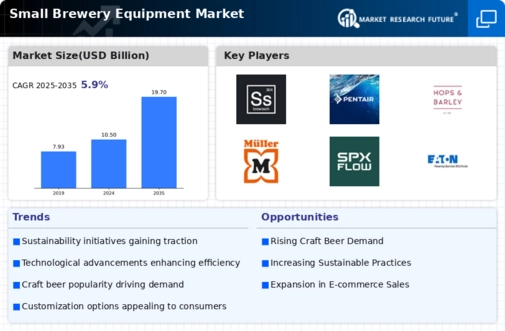Market Growth Projections
The Global Small Brewery Equipment Market Industry is poised for substantial growth, with projections indicating a market size of 10.5 USD Billion in 2024 and a remarkable increase to 19.7 USD Billion by 2035. This growth trajectory suggests a compound annual growth rate (CAGR) of 5.86% from 2025 to 2035. Such figures reflect the increasing investment in small breweries and the rising demand for diverse and innovative beer offerings. As the industry evolves, the market dynamics will likely shift, presenting new opportunities for equipment manufacturers and small brewery operators alike.
Rising Craft Beer Popularity
The Global Small Brewery Equipment Market Industry experiences a notable boost due to the increasing popularity of craft beer. As consumers gravitate towards unique and locally produced beverages, small breweries are emerging to meet this demand. This trend is reflected in the projected market size, which is expected to reach 10.5 USD Billion in 2024. The craft beer movement encourages innovation and diversity in brewing, prompting small breweries to invest in specialized equipment. This shift not only enhances product offerings but also fosters community engagement, thereby solidifying the market's growth trajectory.
Consumer Preference for Local Products
Consumer preference for locally produced products is a driving force in the Global Small Brewery Equipment Market Industry. As consumers become more discerning, they seek out locally crafted beers that reflect regional flavors and traditions. This trend encourages small breweries to invest in equipment that allows for small-batch production and experimentation with unique ingredients. The growing emphasis on local sourcing not only supports community economies but also enhances the market's resilience. The anticipated growth trajectory, with the market expected to reach 19.7 USD Billion by 2035, indicates that this consumer preference will continue to shape the industry.
Regulatory Support for Small Breweries
Regulatory support is a significant driver of the Global Small Brewery Equipment Market Industry. Governments worldwide are recognizing the economic potential of small breweries and are implementing favorable policies to support their growth. This includes tax incentives, grants, and reduced licensing fees, which lower the barriers to entry for new breweries. Such supportive measures encourage entrepreneurship and innovation within the sector. As a result, the market is likely to expand, with small breweries increasingly investing in advanced equipment to meet growing consumer demand. This regulatory environment fosters a thriving ecosystem for small breweries.
Sustainability and Eco-Friendly Practices
Sustainability is emerging as a key driver in the Global Small Brewery Equipment Market Industry. Small breweries are increasingly adopting eco-friendly practices, such as utilizing renewable energy sources and implementing waste reduction strategies. This shift not only appeals to environmentally conscious consumers but also aligns with regulatory trends favoring sustainable production. As breweries invest in sustainable equipment, they can enhance their brand image and attract a loyal customer base. The industry's growth, with a projected CAGR of 5.86% from 2025 to 2035, suggests that sustainability will continue to be a pivotal factor influencing equipment choices.
Technological Advancements in Brewing Equipment
Technological advancements play a crucial role in shaping the Global Small Brewery Equipment Market Industry. Innovations such as automated brewing systems and energy-efficient machinery are becoming increasingly prevalent. These advancements enable small breweries to optimize production processes, reduce operational costs, and improve product quality. For instance, the integration of IoT technology allows for real-time monitoring and control of brewing parameters. As a result, small breweries can enhance their competitiveness in a crowded market. The anticipated growth of the industry, projected to reach 19.7 USD Billion by 2035, underscores the importance of adopting cutting-edge technologies.


















